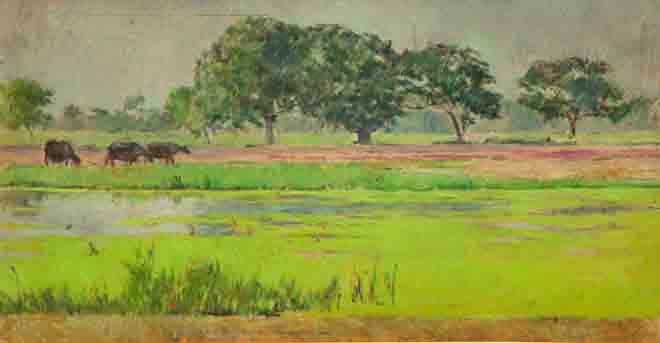

There is no way to know how the soil received the body of the painter who spent his whole life depicting it on his canvases. The death of old, frail and unwell Khalid Iqbal 10 days ago did not come as a surprise but his absence is an unbearable thought. He was not in good health for the past few years but the knowledge of him being at his house in Model Town, Lahore, amid his paints, brushes, boards, books and plants was enough to believe in the normality of life and the art world in Pakistan which is heavily marked by his contributions as a painter and teacher.
I was not fortunate enough to be his student. When I joined the National College of Arts (NCA), he had already left the institution having retired as the Professor of Fine Arts. Yet I was lucky to live in his times. For a young student like me, the physical presence of the artist was important but, more than that, it was the possibility to look at his paintings that became a great learning opportunity.
During my first and second year at NCA, I used to go to the Lahore Museum next door to see his landscapes on display. Since photography was prohibited by the Museum authorities back then too, the only way to document those paintings was to record them through my eyes. I spent hours in front of them, gazing at each detail, capturing it in my memory, taking mental notes of how he had rendered trees, sky, fields, focusing on the brushmarks. I would analyse the layers of paint he had applied to create unbelievable and unforgettable visions of nature on a small surface.
I tried to copy him but soon realised my failure. One can imitate nature but can not reproduce Khalid Iqbal. For him, nature was a way of expressing his own nature.
On the few occasions when I had the honour of meeting him, though briefly, he came across as a polite, pleasant, unassuming and moderate person. The calmness of his manner, the softness of his expressions and the smoothness of his words were all translated into his paintings. In a way the tranquility of Punjab landscape in his work, besides being an observation of outside reality, was a reflection of the artist’s personality.
This aspect of his personality was remembered and recalled when former students, colleagues, fellow artists and admirers of his art came to his funeral. He left no offspring but a legacy in the form of his followers. Perhaps, no other artist in our surroundings had such a large number of painters emulating him or being inspired by him. His landscapes gave birth to a whole school of "Punjab landscape painters". Even though none of them (including his former students at NCA) was able to reach the level of the master, the shadow of Khalid Iqbal can not be missed in their work.
It is not necessary that an artist influences others through his teaching. Sometimes, his presence and work are enough to inspire a generation or generations.
Khalid Iqbal’s death has made many people realise why he was distinct from other landscape painters. It would be incorrect to classify him as a landscape painter; he was in fact an architect of painterly surfaces. The sensitive application of precise amount of paint, the movement of brush in different directions and delicate variation in textures -- all for the sake of rendering a view -- made him unmatchable as an artist. It was the tactile quality of his surfaces which appears in his portraits, figure compositions and still lifes too.
Thus the rendering of reality, capturing of atmosphere, documenting a certain time or season and observing the contours or shapes were not the ultimate goals for the painter. But the way he addressed, experimented and explored his aesthetic concerns made him a master of our times.
A few years ago, I was sitting in the office of a friend who works at Alhamra. While waiting for tea, I kept looking at a landscape of Khalid Iqbal hanging in front of me. I was admiring the way a patch of water was painted surrounded by trees, plants, grass and fields. The water looked almost real with its translucent surface. But the moment I got closer to the canvas, I was surprised to see the water was not painted at all. It was just an empty white patch left untouched. All the rest was painted with such mastery that the flat area of the blank canvas looked like water gathered in a ditch. That day the student who began his artistic journey by studying Iqbal’s paintings -- both at public spaces and in private collections -- finally understood the art of Khalid Iqbal. A minor painter might have daubed the area of water but a genius like him made use of his materials in an intelligent and creative manner.
That difference was evident in his teaching as well because he always encouraged his students to develop their independent views and visions. Thus his students -- even those inspired by him --have worked in a diversity of style, medium, imagery and concept. All owe their success to Khalid Iqbal.
On his funeral, they were all there. That was the first time I went to his house, even though I had been making plans of paying him a visit for years. Regardless of how much I respect and admire him, I was unable to enter the room where his body was lying. How could I have met those eyes which looked at everything around with such pleasure, passion and precision and made it immortal with his incredible art.